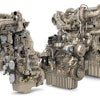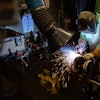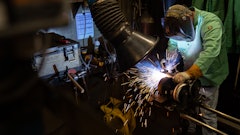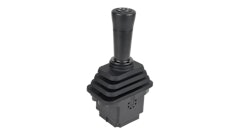The working environment of industrial and utility vehicles can be hard on the sensors inside. These vehicles can experience extreme environmental conditions, including temperatures from –40 to 150 C, shock and vibration to 50gs, exposure to particulate matter and liquid spills.
In order to offer an acceptable level of field reliability, the sensors used within such vehicles to measure speed, direction and angular displacement in the rotating parts must meet two main criteria: accurate sensing and robust packaging that can stand up to physical degradation.
Cherry Electrical Products, Pleasant Prairie, WI, an ISO 9001-certified manufacturer of proprietary and custom electrical switches, sensors and keyboards, has combined the strengths of several proven technologies: magnetic- and inductive-based sensing and polyamide thermoplastic packaging to encase the sensors, using low pressure injection molding (LPIM) to form the parts. This molding process delivers measurable improvements in manufacturing efficiency, quality and reduced costs.
Hall effect sensors
Hall effect sensing provides a means of sensing a measurement in a non-contact manner. When packaged appropriately via LPIM, this technology is excellent for rugged environment applications.
Cherry GS and SD sensors contain integrated circuit Hall effect sensors biased by an internal magnetic field. As a ferrous gear-toothed wheel spins, the Hall effect sensor detects a changing magnetic field when each gear crest transitions to a root. A voltage pulse output is fed into an ECU, which provides a digital reading of speed, speed and direction, or angular position at speeds to 100,000 Hz. The sensors can be used in a wide range of applications in engines and powertrain components.
Cherry's AN angular displacement sensor, on the other hand, uses a programmable Hall IC. Magnets or a flux concentrator are swept in a circular manner past the IC so that magnetic field strength changes from a positive north field to a negative south field. A linear voltage response is obtained from the magnetic-magnitude change. The angular movement sensor is available in either a digital or analog output format.
Thermoplastic polyamide hot melt
Henkel KGaA of Dusseldorf, Germany, developed the idea of supplying customers with its own proprietary formulations of a polyamide resin that would protect electrical components for the typical stresses seen in harsh applications. Henkel introduced the Macromelt OM trade name for the polyamide formulations.
The polyamide thermoplastic material used to fabricate Cherry's family of Hall effect sensors for harsh environments is a version of nylon, developed specifically for insert-molding. However, the two plastics have very marked differences. The polyamide is produced in a somewhat similar way to nylon but its stoichiometric balance is not 1:1. The imbalance leads to a lower viscosity, lower molecular weight and a much more flexible plastic than nylon. Nylon is essentially a harder plastic, used wherever its good abrasion resistance and self-lubricating features are useful, e.g. in gears, bearings and door latches. The lower viscosity and molecular weight in Macromelt OM allows it to be injection molded at a lower pressure than nylon.
The low viscosity of the Macromelt OM resin is perhaps the principal factor in its success in the low pressure injection molding process. The material will flow around the tightest dimensions and smallest spaces without need for the high injection pressure necessary when using traditional resins. This low pressure, typically 50 psi to 150 psi, means the electronic components being encased do not experience the mechanical stresses of flow seen during conventional molding.
A major benefit of Henkel's polyamide material is its exceptional TCE-matching (thermal coefficient of expansion) ability throughout the temperature ranges expected for industrial vehicles. From -40 C to 150 C, Macromelt OM will allow expansion and contraction of the electrical components with no deleterious effect.
Henkel's polyamide has a hardness rating of Shore-A 70-90. It is soft enough to not transfer vibrations to electrical components, yet it can withstand processing heat. The material is processed at temperatures between 200-225 C and can be used within an operating temperature range of –45-170 C. Following application, a rapid cure time means that the molded component is ready within seconds.
The thermal shock characteristics of Macromelt OM are also good. In addition, the material's adhesive properties provide optimal adhesion and create an effective seal for sensors against dust and other environmental contaminants. Cherry's sensors are capable of exceeding the requirements of IEC529 IP code 67, the standard that addresses issues related to water-tight, dustproof conditions.
Macromelt OM is also environmentally-friendly, capable of being produced from recycled raw materials. In addition, during the molding process, no chemical reaction takes place. No solvents or gases are released to the environment.
Processes
All three technologies — high and low pressure molding and potting — have a place in the manufacture of electronics. In the world of molding and encasing technologies, the low pressure injection molding used with Henkel's Macromelt OM polyamide can be thought of as being positioned between conventional high pressure injection molding and potting.
High and low pressure injection molding serve different purposes and niches. Traditional plastics used in high pressure molding, such as nylon, ABS and polyethylene, would not work directly as an encapsulant on a PCB. In addition, high temperatures can melt surface mount components and reflow solder connections. The use of polyamide in low pressure molding can avoid these problems.
If there is any process competition for LPIM in electronic packaging, it is from potting. However, the sequence of steps of the potting process often gives the advantage to LPIM. In addition, Macromelt OM material can typically replace the need for an outer case.
LPIM can also eliminate a significant amount of sealing material on the PCB by profile molding around the larger components, an effect known as "sky-lining".
A closer look at the process
LPIM represents a fast and convenient packaging solution. It is capable of encapsulating circuitry while simultaneously forming the outer shell of the component, to deliver a self-contained and highly integrated assembly.
Compared to two-component part casting and potting using a polyurethane or an epoxy, low pressure molding with polyamide offers the following advantages:
- Short cycle time: The molded component is ready in seconds; hardening of the material is achieved by air cooling.
- Ease of processing: The Macromelt OM material is a single component which lends itself to a clean process.
- Part/process simplification: In many cases the Macromelt OM material can take the place of a structural housing when encapsulating a printed circuit board.
In some situations, however, Macromelt OM resin needs to be supported by a structural plastic.
Simple, inexpensive tooling
As opposed to the tooling associated with conventional molding or potting, the tooling associated with LPIM is relatively simple, requiring only a melt unit, a low pressure dispensing system and a mold. The dispensing system used for the process is ideal for efficient manufacturing, taking up relatively little floor space while being cost-effective and easy to use. Depending on the size of the component (PCB or sensor) being made, the mold system needs the force of only a few newtons.
An inline process, LPIM eliminates the costs of mixing and metering equipment and fixtures needed for epoxy curing. The thermoplastic material cures instantly, eliminating handling and post-cure issues. Custom designs can be offered to manufacturers with minor investments in production fixtures.
A reduction in the injection pressure also leads to savings in the mold itself. Mold bases made from CNC-machined aluminum alloy will suffice in low pressure injection molding. The ease and speed of machining aluminum in comparison to traditional injection molds made from high grade steel provides a significant savings. In addition, low molding pressure means a relatively longer life for these aluminum molds.
Cherry's Hall effect speed sensors, manufactured with low pressure injection molding, have seen use in off-highway vehicles for several years. Sensors are manufactured to a stringent set of industry-accepted test standards that Cherry collected after examining typical applications in off-highway use. Application directed standards include: SAE's J1843 for sensors in over-the-road trucks, SAE J1455 covering environmental parameters, and the J1113 addressing electrical issues like EMI and ESD.
Thermal shock provides for rugged electrical testing. Cherry sensors are exposed to rapid thermal changes as they are shuttled between chambers from –40 C to 150 C. They have been exposed to hundreds of cycles of thermal shock, with a half-hour dwell period at each temperature extreme. The key to this performance is the relative thermal coefficient of expansion (TCE) of the polyamide material.
Conclusion
The proven reliability of Hall effect sensor technology, in conjunction with the advantages of a polyamide thermoplastic resin to encapsulate sensors in a low pressure molding operation, is a formidable combination. Hall effect sensors provide an accurate, non-contacting means to measure linear displacement, speed, or angular position — measurements that are typically required for the reliable control of off-highway vehicles. LPIM provides rugged packaging for the sensor electronics.
Dale Ludwig is new products marketing manager, Cherry Electrical Products, Pleasant Prairie, WI; Michael J. Pierce is a chemist, Henkel Technologies, Irvine, CA.















